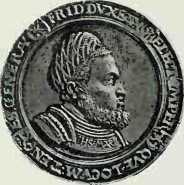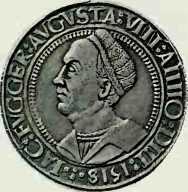While the Reformation was reshaping Europe's religious mores, an economic revolution was changing the daily lives of Protestants and Catholics alike. Under the pressure of expanding trade, the old concepts of barter and land-based wealth gave way to a money economy whose sovereign principle was that capital could and should be used to create more capital. The new materialism was slyly satirized by artist Quentin Massys in the painting above: he showed the moneylender's work distracting his wife's attention from her Bible. Many such merchants won fame, power and even titles. And in their pursuit of profit, they nourished a great boom by developing many business institutions and practices in use today-including stock exchanges, letters of credit, bills of transfer and bank deposits.




SILVER COINS depict the men who minted them. They are, from top, double thalers of Frederick of Saxony, and Albert, Archbishop of Mainz; a half-thaler of Count Jacob Fugger; and a thaler of Emperor Charles V.





 World History
World History









